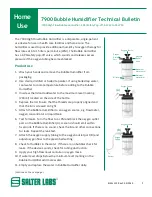
18
Do not reach into the safety guard
openings.
CAUTION!
Crushing or ergonomic
damage when transporting the ad-
sorption-dehumidifier!
Use the handles to transport the ad-
sorption-dehumidifier.
ASE 400 should always be trans-
ported by two people.
Procedure
1. Make sure that the hoses (optional
accessory) are removed from the
regeneration air outlet and the dry
air outlet and that the power cable is
disconnected from the unit.
2. Make sure that no particles or
smoke, gas or similar may be
drawn in and that the negative
pressure created does not have a
negative impact on safety or on the
unit.
3. Transport the adsorption-dehumidi-
fier to the place of use.
ATTENTION! Damage to the device!
During operation, suction is created at
the process air inlet. This suction may
draw in paper or other light objects.
When the process air inlet is covered,
the unit may be damaged.
Make sure that no objects may be
drawn in.
The air must circulate freely. Do not
cover the air openings.
ASE 400: Connecting the external
control system
If required, the ASE 400 may be con-
trolled externally. The external control
system must be suitable for at least
10 A.
Procedure
1. Connect the external control system
to the port for the external control
system.
2. Follow the operating instructions for
the external control system.
Connecting the hoses/air ducts
In order to operate properly, a hose or
air duct must be used to drive the re-
generation air out of the room (e.g.
through a window). To do this, a suita-
ble hose/air duct must be connected to
the regeneration air outlet.
If required, a hose can be used to guide
the dry air to the place of use. To do this,
connect a suitable hose to the dry air out-
let.
ATTENTION!
Inadequate appliance
output!
Do not bend the hose.
Do not place any objects on the
hose.
Procedure for regeneration air
1. Connect hose/air duct (DN 80 mm)
to the regeneration air outlet and
secure with a clamp, for example.
ASE 200/300:
Regeneration air
outlet on the front
ASE 400:
Regeneration air outlet
on the back.
2. Lay the hose/air duct so the regen-
eration air is directed out of the
room. Make sure that the hose
slopes away from the adsorption-
dehumidifier so that no condensate
can get into the unit.
If it is not possible to create a
slope, bend the hose/air duct down
slightly. Drill a hole (D=4 mm) at
the lowest point of the bend so the
condensate can drain.
Procedure for dry air
1.
ASE 200/300 only:
The dry air out-
let is on the back. The connection
plate can be turned, depending on
the type of hose (
ASE 200:
2 x DN
50 mm or 1 x DN 80 mm
ASE 300:
2 x DN 50 mm or 1 x DN
Summary of Contents for ASE 200
Page 135: ...135...
















































